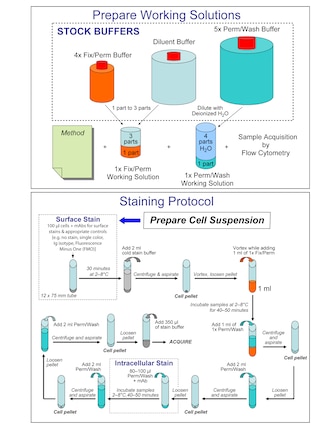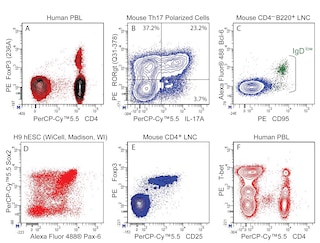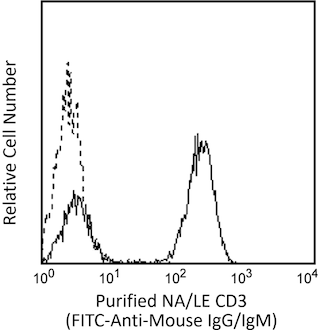-
Your selected country is
Middle East / Africa
- Change country/language
Old Browser
This page has been recently translated and is available in French now.
Looks like you're visiting us from {countryName}.
Would you like to stay on the current country site or be switched to your country?


.png)

Flow cytometric analysis of BATF expression in Human and Mouse Lymphocytes. Left Panel - Human peripheral blood mononuclear cells (PBMC) were cultured (3 days) with immobilized Purified NA/LE Mouse Anti-Human CD3 (Cat. No. 555329; 10 µg/ml for plate coating) and soluble Purified NA/LE Mouse Anti-Human CD28 (Cat. No. 555725; 2 µg/ml) antibodies. Freshly-prepared PBMC from the same donor (dotted line histograms) and the stimulated PBMC (solid line histograms) were fixed and permeabilized using the BD Pharmingen™ Transcription Factor Buffer Set (Cat. No. 562574/562725). The cells were then stained with either PE Mouse IgG1, κ Isotype Control (Cat. No. 554680; Left Plot) or PE Mouse Anti-Human BATF antibody (Cat. No. 564503; Right Plot). Right Panel - Mouse splenic leucocytes were cultured (3 days) with plate-bound Purified NA/LE Hamster Anti-Mouse CD3e (Cat. No. 553057; 10 μg/ml for coating) and soluble Purified NA/LE Hamster Anti-Mouse CD28 (Cat. No. 553294; 2 μg/ml) antibodies. Freshly-prepared splenic leucocytes (dotted line histograms) and the stimulated splenocytes (solid line histograms) were fixed and permeabilized using the BD Pharmingen™ Transcription Factor Buffer Set. The cells were then stained with either PE Mouse IgG1, κ Isotype Control (Left Plot) or PE Mouse Anti-Human BATF antibody (Right Plot). Fluorescence histograms showing the expression of BATF or Ig Isotype control staining were derived from gated events with the forward and side light-scatter characteristics of intact lymphocytes. Flow cytometric analysis was performed using a BD LSRFortessa™ Cell Analyzer System.
.png)

BD Pharmingen™ PE Mouse anti-BATF
.png)
Regulatory Status Legend
Any use of products other than the permitted use without the express written authorization of Becton, Dickinson and Company is strictly prohibited.
Preparation And Storage
Product Notices
- This reagent has been pre-diluted for use at the recommended Volume per Test. We typically use 1 × 10^6 cells in a 100-µl experimental sample (a test).
- Please refer to www.bdbiosciences.com/us/s/resources for technical protocols.
- Source of all serum proteins is from USDA inspected abattoirs located in the United States.
- An isotype control should be used at the same concentration as the antibody of interest.
- Caution: Sodium azide yields highly toxic hydrazoic acid under acidic conditions. Dilute azide compounds in running water before discarding to avoid accumulation of potentially explosive deposits in plumbing.
- For fluorochrome spectra and suitable instrument settings, please refer to our Multicolor Flow Cytometry web page at www.bdbiosciences.com/colors.
Companion Products






The S39-1060 monoclonal antibody specifically binds to BATF. BATF is also known as B-cell-activating transcription factor, Activating transcription factor B, Basic leucine zipper transcription factor ATF-like, and SF-HT-activated gene 2 protein (SFA-2). BATF is a 14 kDa basic leucine zipper protein that belongs to the AP-1/ATF superfamily of transcription factors. It is upregulated in activated T cells when compared to naïve T and B cells. BATF functions by dimerizing with members of the Jun transcription factor family and binds to AP-1 DNA sequences. BATF plays roles in the differentiation of Th9 cells, Th17 cells, T follicular helper cells, CD8+ effector T cells, CD8+ dendritic cells, Ig isotype-switching B cells, and possibly Th2 cells.

Development References (7)
-
Betz BC, Jordan-Williams KL, Wang C, et al. Batf coordinates multiple aspects of B and T cell function required for normal antibody responses. J Exp Med. 2010; 207(5):933-942. (Biology). View Reference
-
Dorsey MJ, Tae HJ, Sollenberger KG, Mascarenhas NT, Johansen LM, Taparowsky EJ. B-ATF: a novel human bZIP protein that associates with members of the AP-1 transcription factor family. Oncogene. 1995; 11(11):2255-2265. (Biology). View Reference
-
Ellyard JI, Vinuesa CG. A BATF-ling connection between B cells and follicular helper T cells. Nat Immunol. 2011; 12(6):519-520. (Biology). View Reference
-
Ise W, Kohyama M, Schraml BU, et al. The transcription factor BATF controls the global regulators of class-switch recombination in both B cells and T cells. Nat Immunol. 2011; 12(6):536-543. (Biology). View Reference
-
Jabeen R, Goswami R, Awe O, et al. Th9 cell development requires a BATF-regulated transcriptional network. J Clin Invest. 2013; 123(11):4641-4653. (Biology). View Reference
-
Schraml BU, Hildner K, Ise W, et al. The AP-1 transcription factor Batf controls T(H)17 differentiation. Nature. 2009; 460(7253):405-409. (Biology). View Reference
-
Tussiwand R, Lee WL, Murphy TL, et al. Compensatory dendritic cell development mediated by BATF-IRF interaction. Nature. 2012; 490(7421):502-507. (Biology). View Reference
Please refer to Support Documents for Quality Certificates
Global - Refer to manufacturer's instructions for use and related User Manuals and Technical data sheets before using this products as described
Comparisons, where applicable, are made against older BD Technology, manual methods or are general performance claims. Comparisons are not made against non-BD technologies, unless otherwise noted.
For Research Use Only. Not for use in diagnostic or therapeutic procedures.
Report a Site Issue
This form is intended to help us improve our website experience. For other support, please visit our Contact Us page.